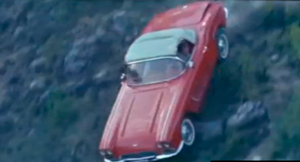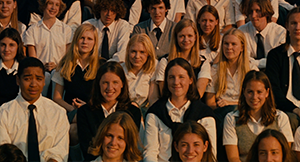Tecmerin. Journal of Audiovisual Essays
Issue 15 – 2025 (1)
Cars Haunt Our Dreams: Spanish Film, Desarrollismo, and the Automobile
Nathaniel McBride (The Ohio State University)
How to cite this article: McBride, Nathaniel (2025). El automóvil en el cine desarrollista español/Cars Haunt Our Dreams: Spanish Film, Desarrollismo, and the Automobile, Tecmerin. Journal of Audiovisual Essays , 15, 2025(1). ISSN: 2659-4269
The automobile emerged contemporaneously with film. From the Lumière days, the moving vehicle enabled filming “panoramas” of motion that represented modernity, as demonstrated in this video’s prologue. Quintana (2019) has observed that, in addition to modernity’s “nouvelles formes de perception,” such shots document the physical, historical reality of their (often urban) landscapes (pp. 24–25). This video examines the documentation and commentary on rising car culture in postwar Spanish film from an ecocritical perspective.
While the US boasted thirty million cars before the war, and other nations had their “people’s car” such as the Volkswagen as early as 1936, Spain’s counterpart would arise in 1957: the SEAT 600 (Pavlović, 2011, pp. 183, 185). Between 1960 and 1973, Spanish households with an automobile would rise from 1 in 25 to over 1 in 3, paralleling other consumer machines such as television sets and refrigerators (García Ochoa, 2012, p. 117). This period of economic change through national and international investment in Spain’s planned GDP growth is known as the era of “Desarrollismo.”
In Part 1, this video illustrates how Communist-affiliated director Juan Antonio Bardem engages with the social implications of the automobile in his early work (1951–1964). Emphasis on modes of transportation parallels the filmmaker’s considerate attention of economic disparity between characters—e.g., a working-class cyclist killed by upper-class motorists (Zuwiyya, 2024). These narratives prefigure and document the rising car industry and declining investment in railroads from the mid-1950s onward (Pavlović, 2011, p. 146). In Bardem’s cinema, cars (and other gasoline-run vehicles such as farm equipment) stand for economic privilege and often carry fatal consequences for the rich and poor alike, while trains, buses, cycling, and walking represent socially accessible modes of mobility.
Parts 2 and 3 address the double ambivalence of cars’ social signification in Desarrollista-era film. While popular musicals uncritically celebrated consumer culture, the far right and left found unlikely common ground in denouncing the car as the ultimate symbol of globalized capital (objecting to the globalized and to capital, respectively). Yet, this dominating machine simultaneously serves as a vehicle for social empowerment—particularly for women, who enjoyed increasing social mobility during these years (Gil Vázquez, 2023). However, an ecofeminist response to this insight of liberal feminism maintains that these social benefits do not eliminate the objective physical and economic domination inherent in car culture, nor the variations on dominating masculinity culturally constructed alongside it. We see an extreme representation of such destructive masculinity in Un chien andalou (Luis Buñuel, 1929), echoed across the Desarrollista-era films of Carlos Saura.
Pavlović (2011) has offered two interpretations of the frequent association between cars and violence in this era’s literature and film:
The death and violence in these texts may be read as an ineluctable return of the trauma of the Civil War . . . Or these mayhems of fiction may be construed as another type of traumatic loss, that of politics proper and the end of the Left-wing struggle that informed the earlier literary production of these intellectuals. (p. 190)
To suggest a third explanation, this video essay concludes with the car-bomb assassination of Luis Carrero Blanco, the dictator’s chosen authoritarian successor (recreated for the film Operación Ogro, directed by Gillo Pontecorvo in 1979). Augé (1992/2008) has suggested that terrorists attack the impersonal, de-historicized non-places of supermodernity (airports, train stations, cars) because these represent the empty opposite of utopia (p. 90). In this light, this crime points to the contextual and inherent relations between domination and the automobile itself. In film, artists expressed not only a lost Civil War, but the contemporary violence implicit in this elitist modernization that, as Hofmann (2023) has demonstrated, was an authoritarian means to preserve the dictator’s anti-democratic regime. Politics had not disappeared, despite the regime’s best efforts (pp. 71, 94, 136–38, 227, 406–07; Riquer i Permanyer, 1995, pp. 268–70). Rather, the Left-wing struggle found itself in need of a pivot, as Latour (2018) has proposed, away from the ideal of globalized progress, “down to earth”—a shift in priorities that various activist movements carried out (Corral-Broto & Ortega Santos, 2021); a path that these filmmakers traced for us.
This is not to suggest that these dissident filmmakers consciously denounced car culture as ecologically corrosive in the sense of a still nascent environmentalism. However, to the extent that issues of modernization, economic privilege, and feminism show up as central patterns in these works, and that these issues are inextricable from environmental concerns, an ecofeminist reading serves, in Bakhtin’s (1981) terms, to re-accentuate the contemporary insights already available in these texts (pp. 410, 420–21).
Bibliography
Augé, M. (2008). Non-Places: An introduction to supermodernity (2nd ed., J. Howe, Trans.). Verso. (Original work published 1992)
Bakhtin, M. (1981). The dialogic imagination: Four essays (M. Holquist, Ed. C. Emerson & M. Holquist, Trans.). University of Texas Press.
Bauman, Z. (2007). Liquid times: Living in an age of uncertainty. Polity.
Beilin, K. O. (2015). In search of an alternative biopolitics: Anti-Bullfighting, animality, and the environment in contemporary Spain. The Ohio State University Press.
Corral-Broto, P., & Ortega Santos, A. (2021). A simple overflow? Environmental coloniality in Francoist Spain (1950–1979). Perspectivas: Journal of Political Science, 25, 29–42. https://doi.org/10.21814/perspectivas.3564
Daggett, C. (2018). Petro-Masculinity: Fossil fuels and authoritarian desire. Millennium: Journal of International Studies, 47(1), 25–44. https://doi.org/10.1177/0305829818775817
Dyer, Richard. (2002). Entertainment and utopia. In Only entertainment (2nd ed., pp. 19–35). Routledge.
García Ochoa, S. (2012). Automóvil y cine en la España desarrollista: Peppermint frappé (Carlos Saura, 1967). Hispanic Research Journal, 13(2), 111–130. https://doi.org/10.1179/174582012X13257549228570
Gil Vázquez, Asier. (2023). A-Ten-Thousand-Legs Madrid. Tecmerin. Journal of Audiovisual Essays, 12(2). https://tecmerin.uc3m.es/project/a-ten-thousand-legs-madrid/?lang=en
Hofmann, A. C. (2023). Una modernidad autoritaria. El desarrollismo en la España de Franco (1956-1973) (C. F. Gil, Trans.). Universitat de València.
Instituto Nacional de Estadística. (1960). Anuario 1960. https://ine.es/inebaseweb/treeNavigation.do?tn=174023
Latour, B. (2018). Down to Earth: Politics in the New Climactic Regime (C. Porter, Trans.). Polity.
Pavlović, T. (2011). The mobile nation: España cambia de piel (1954–1964). Intellect.
Prádanos, L. I. (2018). Postgrowth imaginaries: New ecologies and counterhegemonic culture in post-2008 Spain. Liverpool University Press. https://muse.jhu.edu/book/72678
Quintana, À. (2019). Le paysage vu à travers la vitre de la voiture. Capturer des paysages. In J. Balló & A. Bergala (Eds.), Les motifs au cinéma (pp. 20–25). Presses universitaires de Rennes.
Riquer i Permanyer, B. de. (1995). Social and Economic Change in a Climate of Political Immobilism. In H. Graham & J. Labanyi, Spanish Cultural Studies: An Introduction (pp. 259–271). Oxford University Press.
Zuwiyya, D. (2024, 20 April) The Role of the Bicycle in La nueva movilidad [Conference session]. Kentucky Foreign Language Conference, University of Kentucky, Lexington, KY, United States.
Tecmerin. Journal of Audiovisual Essays
ISSN: 2659-4269
© Grupo de Investigación Tecmerin
Universidad Carlos III de Madrid






